Salesforce AI in 2025: What Actually Matters for Your Organisation
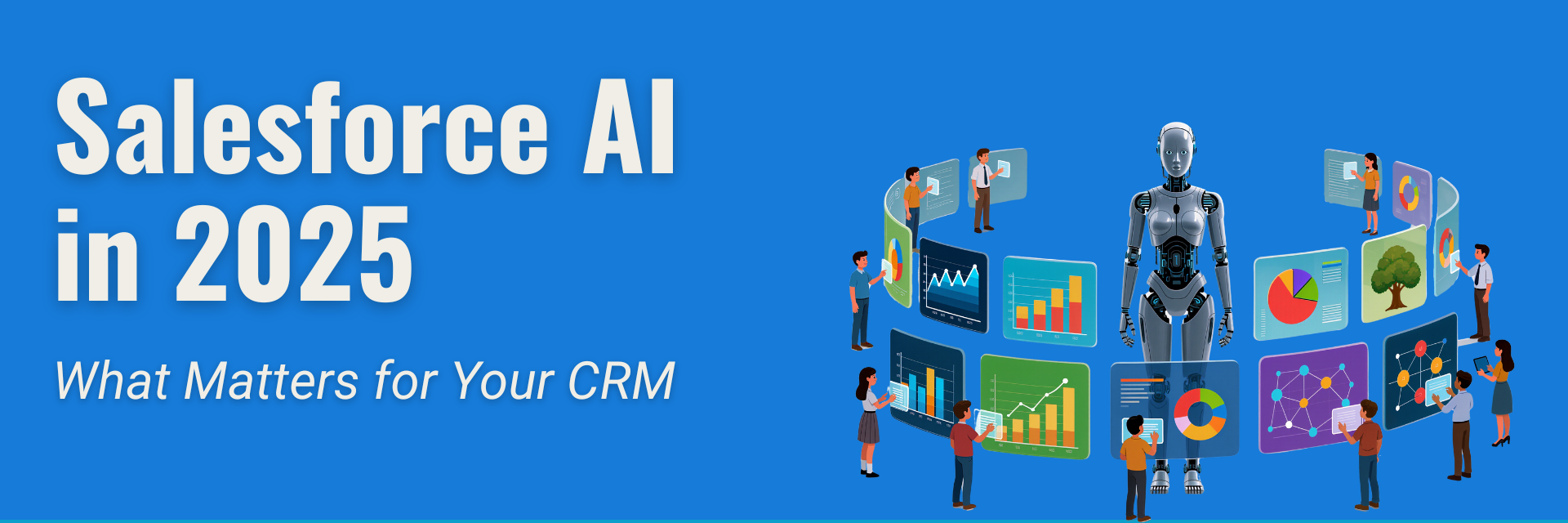
Salesforce has moved fast into AI. Einstein 1, Data Cloud, Agentforce, Slack AI, new releases every few months.
If you are responsible for revenue, operations or technology, it may feel exciting and overwhelming at the same time. Licences are getting more powerful, but your reality may still be dashboards exported to Excel, manual handoffs and AI pilots that never quite go live.
This article cuts through the noise and focuses on what has really changed in Salesforce, where most organisations get stuck, and how to start unlocking value in a realistic way.
1. Salesforce is now an AI and data platform, not “just CRM”
The biggest shift is strategic. Salesforce is repositioning Customer 360 around Einstein 1 and Data Cloud, so your CRM becomes a real time data and AI platform, not only a system of record.
Data Cloud sits at the centre. It connects data from your Salesforce orgs and from external systems, builds unified customer profiles and makes that context available to AI, analytics and automation. If AI is the brain, Data Cloud is the nervous system.
On top of that, Salesforce has introduced Agentforce. This is an AI helper and agent embedded inside Sales, Service and other clouds. It can summarise records, suggest next actions, generate content and trigger Flows from natural language, without forcing your teams to learn a new tool.
The message is clear. Salesforce is no longer adding AI as a side feature. It is rebuilding the platform around AI and data.
2. Why most organisations are not seeing the value yet
When we talk to leaders, three pain points appear again and again.
Fragmented data
Customer interactions, contracts, product usage and finance data live in different systems, owned by different teams. AI cannot make good decisions if it does not see the full picture or if basic fields are incomplete and inconsistent.
Complex, fragile processes
Years of urgent requirements have created layers of flows, rules and workarounds. Nobody feels comfortable touching them. New AI features are dropped on top of this, which makes everything feel more unpredictable instead of more intelligent.
Lack of AI governance
Everyone wants automation. Nobody wants a compliance issue or a bad customer experience. If there are no agreed guardrails, legal and security teams slow things down, often for good reasons, and AI projects stay in pilot mode.
The result is a familiar pattern. The organisation pays for powerful Salesforce capabilities, but day to day, teams still rely on manual work and side spreadsheets.
3. What to focus on now
You do not need to implement every new feature to benefit from this new Salesforce wave. You need a sequence.
Start with the data that matters most
Pick one or two high-value slices of data, such as customer profiles and recent interactions, and focus on making them clean, connected and available in Data Cloud. The goal is not perfection. The goal is an initial, trusted foundation that AI can use.
Choose a small number of focused AI use cases
Instead of “doing AI everywhere”, pick one or two scenarios with clear outcomes. For example, inbound lead qualification, first-line support for a defined set of cases, or an internal knowledge assistant for your sales or service team. Design them so that humans stay in the loop, especially at the start.
Design governance from day one
Agree what AI agents can and cannot do. Decide where a human must approve actions, what is logged, and how issues will be reviewed. This makes legal and security part of the solution, not blockers at the end.
Invest in people, not only in licences
AI features will keep evolving. Your real advantage is people who know how to work with them. Train admins, architects and business owners on how to design prompts, flows and guardrails. Help users understand when to trust AI, when to question it and how to give feedback.
4. How Target Everest fits into this picture
If you have not come across us before, we are a specialist consultancy that works at the intersection of Salesforce architecture, data, AI and strategy. We focus on turning platforms into performance, not just technology into licences.
In practice, that means we help organisations:
- Analyse their current Salesforce landscape and identify where data and processes block AI.
- Design an architecture that makes sensible use of Einstein 1, Data Cloud, Agentforce and Slack AI, without over-complicating things.
- Prioritise a small number of AI use cases that map directly to revenue, service or efficiency outcomes.
- Run safe pilots and then scale what works, with governance and change management built in.
The outcome is simple. Fewer disconnected pilots. More visible value, faster, from the Salesforce investments you already have and the AI capabilities that are arriving.
If you recognise these pain points and would like to explore what an AI-ready Salesforce roadmap could look like for your organisation, we are always open to a conversation.
The Protocol Everybody’s Thinking About: MCP and the Future of AI in Salesforce
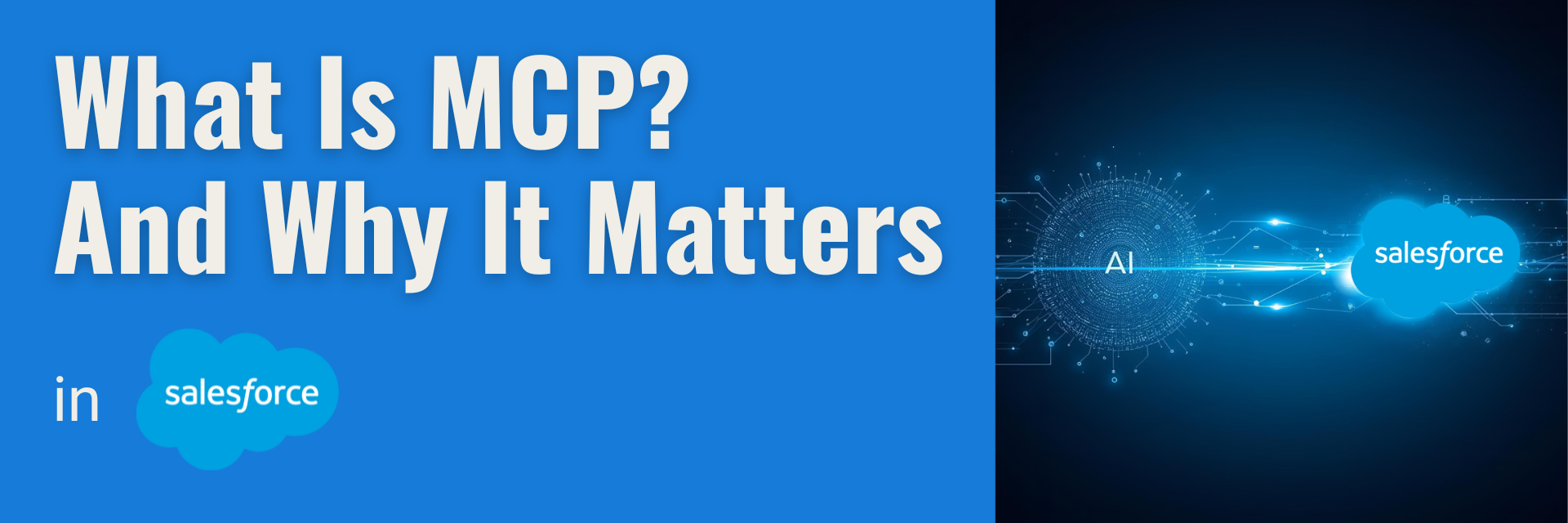
Artificial intelligence is transforming the Salesforce ecosystem faster than ever.
But have you ever wondered how these smart systems actually connect with data, apps, and workflows?
The answer lies in something new and something everyone in the Salesforce world will soon be thinking about: the Model Context Protocol.
What Is the Model Context Protocol?
The Model Context Protocol (MCP) is an open standard designed to make AI connections simple, secure, and consistent.
Think of it as the USB-C of AI: one universal connector that lets different AI systems speak the same language when interacting with data and tools.
In the context of Salesforce, the MCP allows AI models to securely access information from multiple systems without complex custom integrations.
It defines a clear, structured way for AI to find the right data, understand its context, and perform actions when needed.In short, MCP builds a standard bridge between AI and Salesforce data – helping automation become more intelligent and more connected.
Why the Model Context Protocol in Salesforce Matters
Salesforce has already started supporting the MCP within its new AI framework, Agentforce.
This means that intelligent agents inside Salesforce can now:
- Retrieve data from Sales, Service, or Marketing Cloud
- Connect to external apps and databases through a secure “interface bridge”
- Trigger Salesforce automations like Flows, Approvals, or Apex actions
For Salesforce admins and AI enthusiasts, this is a big deal.
It’s not just about asking AI to summarize data anymore – soon, AI will be able to take action directly inside your org, based on real-time context.
How It Works (Without the Jargon)
Every MCP setup has two main parts:
- the MCP client, which is the AI system asking for information (for example, Agentforce or another AI assistant), and
- the MCP server, which provides access to the right data or actions.
When they connect, the client asks, “What resources or tools can I use?”
The server then replies with a list of available options – such as datasets, APIs, or commands.
From there, the AI can execute actions in Salesforce safely, without the need to hard-code every integration.
It’s all done through a standardized, secure framework, which makes development faster and governance easier.
Why Everyone’s Thinking About MCP
Even though MCP is still new, it’s already being called the future “glue” of AI integration.
Salesforce’s decision to adopt it shows a clear direction: a world where AI agents are open, interoperable, and context-aware.
For Salesforce professionals, learning about the MCP now is like getting an early look at how AI and CRM will merge over the next few years.
It’s the foundation for smarter, more connected workflows and the kind of automation that truly feels intelligent.
Built with Trust and Security in Mind
Security has always been part of Salesforce’s DNA, and the MCP follows the same principle.
It uses standard Salesforce authentication and permissions, meaning AI agents can only access what their user or app is allowed to.
No shortcuts, no open back doors – just governed, scalable access to data.
Looking Ahead
The MCP in Salesforce is still evolving, but its direction is clear.
In the near future, AI assistants will become real teammates – not just answering questions, but completing tasks, managing workflows, and learning from context.
This shift will redefine what efficiency means for Salesforce teams.
And those who understand MCP early will be ready for what’s coming next.
Final Thought
At Target Everest, we see the MCP as more than just another technical update.
It’s a symbol of connection, linking people, data, and intelligent systems in a smarter way.
MCP marks the beginning of a new chapter where AI and Salesforce work hand in hand, creating smarter, more connected business solutions.
Explore more articles on our blog!
Life Sciences at Crossroads: Navigating the Veeva–Salesforce Split
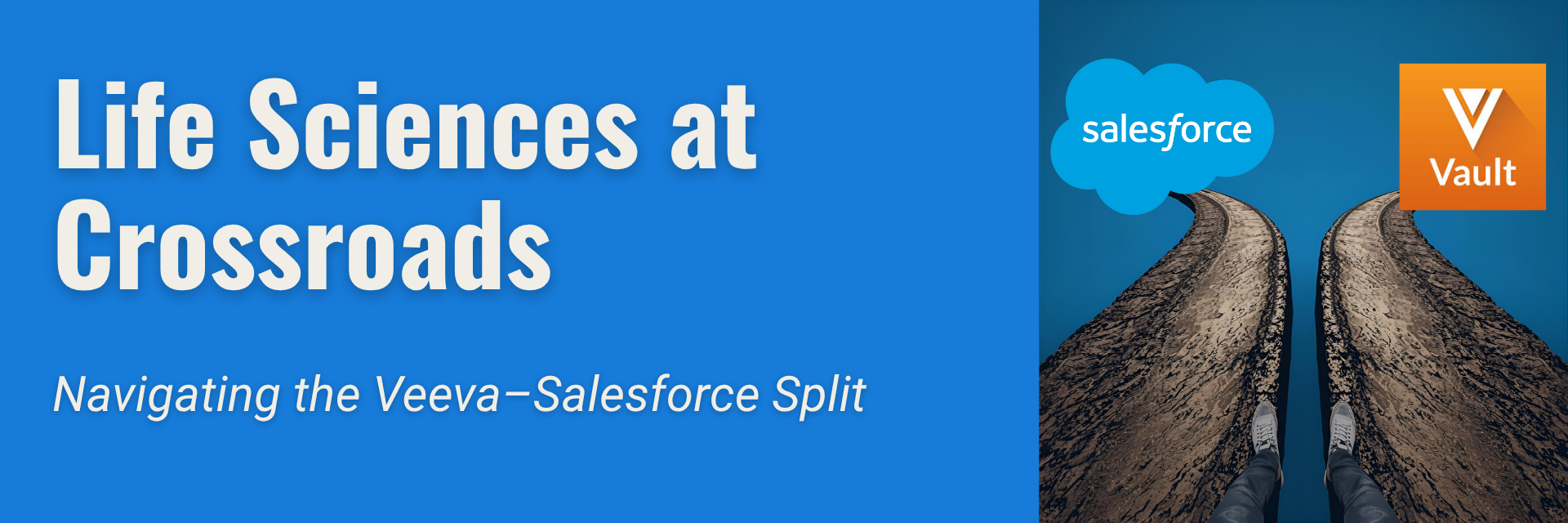
For years, Veeva CRM has been the go-to solution for life sciences companies that wanted an industry-tailored CRM system. Now, with the Salesforce vs Veeva in Life Sciences landscape evolving, organizations are facing an important crossroads for their future strategy.
That landscape is now changing. Earlier announcements confirmed that Veeva will gradually move away from the Salesforce ecosystem and transition its CRM offering to a new platform: Veeva Vault CRM. At the same time, Salesforce is introducing its own Life Sciences Cloud, designed to support pharmaceutical and biotech organizations natively within the Salesforce environment.
This shift marks a turning point for the industry. Companies that have long relied on Veeva CRM will soon need to evaluate how their CRM and content strategies should evolve.
Why this matters now
At first glance, the timeline might seem generous. Current Veeva CRM deployments will remain supported until 2030. However, Veeva has made clear that its strategic innovation focus will shift toward Vault CRM. That means while customers can continue using Veeva CRM on Salesforce, the most advanced developments and new features will primarily appear in the Vault ecosystem.
For life sciences organizations, this is less about a distant deadline and more about starting preparations today. Migrating complex data models, ensuring regulatory compliance, and retraining users are not overnight projects. The companies that begin planning early will be the ones that transition smoothly. In the context of the Salesforce vs Veeva in Life Sciences transformation, those preparations are becoming even more critical.
Navigating the Salesforce vs Veeva in Life Sciences Split
As the split unfolds, Salesforce vs Veeva in Life Sciences is no longer a simple “either–or” decision. In practice, there are three main approaches:
1. Stay with Salesforce – and move to Life Sciences Cloud
Salesforce is extending its industry solutions with the new Life Sciences Cloud, which connects seamlessly to the wider Salesforce ecosystem. For companies already using Salesforce Marketing Cloud, Service Cloud, or Data Cloud, this provides continuity and the ability to harness AI innovations such as Agentforce.
The advantage is clear: staying within Salesforce means staying part of a vast, integrated ecosystem—one that continues to invest heavily in innovation and compliance capabilities.
2. Transition fully to Veeva Vault CRM
Veeva, on the other hand, is moving CRM into its own Vault platform. This brings CRM closer to Veeva’s existing strengths in content, clinical, and regulatory solutions. For organizations deeply invested in the Veeva ecosystem, this might feel like a natural extension.
3. Hybrid approach
Some organizations may also choose a hybrid model: keeping Salesforce as their CRM system, while leveraging Veeva Vault specifically for healthcare or clinical content management. This approach allows companies to benefit from both platforms, though it comes with additional integration and governance considerations.
A decision point for life sciences companies
There is no single right answer for every organization. Each path has its benefits and challenges, and the right decision depends on:
- Existing ecosystem: How deeply is your company tied into Salesforce today?
- Future needs: Will advanced AI, data unification, and omnichannel engagement be central to your strategy?
- Compliance and regulation: Which platform best aligns with your validation and audit requirements?
- Cost and resources: What will migration mean for your teams, budgets, and timelines?
What is certain is that doing nothing is not a strategy. Waiting until 2029 to evaluate options would put enormous pressure on budgets, teams, and compliance timelines. For companies affected by the Salesforce vs Veeva in Life Sciences shift, acting early will define long-term success.
Salesforce Life Sciences Cloud: the future-ready choice
- Integrations: Native connection with Salesforce Marketing Cloud, Service Cloud, and Data Cloud ensures a unified ecosystem.
- AI, Machine Learning & Agentforce: Salesforce is continuously embedding generative AI and machine learning into the Life Sciences Cloud. This not only supports sales and customer engagement but also enables predictive insights, personalized recommendations, and smarter resource planning.
- Scalability: The platform grows with your business, adapting to new products, markets, and customer needs.
- Security & Compliance: Built-in trust and compliance features safeguard sensitive health and patient data.
- Ecosystem advantage: A broad partner network, AppExchange solutions, and a global developer community that no single vendor can match.
How to approach the transition
The most important step companies can take right now is to start the conversation internally. Identify stakeholders across commercial, regulatory, and IT. Map out your current integrations. Assess how critical Salesforce-native AI or Veeva’s content-driven approach will be for the future.
From there, engaging with partners who understand both platforms—and who can provide objective guidance—becomes essential. The decision you make will shape not just technology, but also customer engagement, compliance posture, and long-term agility.
Moving forward
The Veeva–Salesforce split represents more than a technical change; it’s a moment of reflection for life sciences organizations. The question is not just “Which system should we use?” but rather “How do we want to engage with customers, manage data, and stay compliant over the next decade?”
At Target Everest, we see this transition as an opportunity. As a Salesforce partner, we help organizations explore what the Life Sciences Cloud can offer, build migration strategies, and ensure that the shift strengthens—not disrupts—business. Our role is not just to implement software, but to guide companies through change with clarity and confidence.
Final thought
Every transformation comes with challenges, but also with the chance to reimagine how things are done. The life sciences sector is now standing at crossroads. Whether your organization chooses Salesforce, Veeva Vault, or a hybrid path, the key is to start preparing today.
And if you’re wondering how to take the first step, know that you don’t have to navigate it alone.
Disclaimer:
This article reflects the current state of the Salesforce and Veeva roadmaps as of October 2025. Organizations should always verify the latest updates and evaluate their own CRM strategy based on the most recent information available.
Explore more articles on our blog!
Salesforce-Powered Digital Transformation for Every Business

Digital transformation is no longer a trend — it is a critical necessity for companies that wish to remain competitive in today’s fast-paced market. As one of the leading CRM platforms worldwide, Salesforce plays a central role in this shift, helping businesses of all sizes to innovate, automate, and optimise their operations.
In this article, we explore how Salesforce empowers digital transformation by delivering measurable improvements across customer service, sales, marketing, and data analysis.
The Strategic Role of Digital Transformation
Digital transformation refers to the integration of digital technologies into all areas of a business, fundamentally changing how it operates and delivers value to customers.
With Salesforce, companies can accelerate this transition, adopting more agile, data-driven models. Whether it’s a fast-growing start-up or a global enterprise, Salesforce provides scalable tools to support evolving digital needs.
1. Enhancing Customer Experience — The Heart of Digital Transformation
One of the most powerful ways Salesforce enables digital transformation is by enhancing the customer experience. Through platforms like Sales Cloud, Service Cloud, and Marketing Cloud, companies can centralise all customer interactions in one place, ensuring faster, more personalised, and more efficient service.
Sales Cloud
Streamlines lead, opportunity, and account management — making sales processes more structured and effective.
Service Cloud
Provides omnichannel customer support — including phone, email, live chat, and even AI-powered chatbots — improving response times and resolution rates.
Marketing Cloud
Enables hyper-personalised digital campaigns that help businesses connect with customers in more direct and relevant ways.
These tools ensure that every customer touchpoint is tracked, measured, and optimised — a fundamental principle of customer-centric digital transformation.
2. Internal Process Optimisation with Salesforce
Beyond external engagement, Salesforce also helps optimise internal workflows and collaboration. Its automation and analytics capabilities reduce repetitive manual tasks, minimise errors, and empower teams to work more intelligently.
Salesforce Flow
Automates business processes without the need for code, enabling teams to create guided workflows, approval processes, and task automation.
Einstein Analytics (now CRM Analytics)
Delivers predictive insights and real-time dashboards, helping managers and teams make informed decisions based on accurate data.
The result is not just operational efficiency, but a shift towards proactive, insight-driven business management.
3. Designed for Businesses of All Sizes
One of Salesforce’s key strengths is its scalability. Whether you’re a small business beginning your digital journey or a large enterprise seeking to transform complex operations, Salesforce provides tailored solutions to suit your stage and sector.
Small and Medium Businesses (SMBs)
Salesforce Essentials offers an affordable, easy-to-use CRM that helps small teams manage sales, service, and customer communications in one central system.
Large Enterprises
Salesforce provides an advanced, customisable platform with industry-specific solutions through Salesforce Industries, enabling a deeper level of specialisation in sectors like finance, healthcare, manufacturing, and more.
Regardless of size, all businesses benefit from Salesforce’s robust cloud infrastructure, regular innovation, and trusted security.
4. Seamless Integration with Other Business Tools
A major advantage of Salesforce is its integration capabilities. Organisations can connect Salesforce with legacy systems, e-commerce platforms, productivity apps, and more — creating a cohesive digital ecosystem that supports true digital transformation.
ERP and Other Platforms
Salesforce integrates smoothly with ERP systems, enabling real-time data exchange and better visibility across departments like finance, sales, and operations.
AppExchange
Salesforce’s marketplace offers thousands of pre-built applications that extend and customise the platform to match each business’s unique needs — from accounting tools to marketing automation plugins.
This flexibility allows companies to future-proof their systems and continuously evolve without starting from scratch.
5. Data as the Foundation for Strategic Decisions
Salesforce puts data at the core of decision-making. With Einstein AI and advanced analytics tools, businesses can uncover patterns, anticipate customer behaviour, and respond to market changes with agility.
Einstein AI
Features include sales forecasting, product recommendations, and customer behaviour analytics — enabling companies to fine-tune their strategies with greater precision.
Custom Reports and Dashboards
Salesforce’s reporting tools allow users to build tailored dashboards, monitor KPIs, and generate real-time insights to support continuous improvement.
With these capabilities, decision-making becomes faster, smarter, and backed by actionable intelligence — giving organisations a strong competitive edge.
Conclusion
Salesforce is a driving force behind digital transformation for businesses across the globe. From improving the customer journey to streamlining internal processes and enabling data-driven strategies, its platform offers a comprehensive, flexible, and scalable solution.
Whether you are a start-up seeking to professionalise operations or an enterprise pushing the boundaries of digital innovation, Salesforce provides the technology and ecosystem to support your evolution.
By embracing Salesforce, companies position themselves not just to keep up with the digital economy — but to lead in it.
Want to see how to scale processes and decision-making with Salesforce? Fill out the form below to book a personalized demo.
Explore more articles on our blog!
Marketing Automation: Targeted Campaigns That Convert
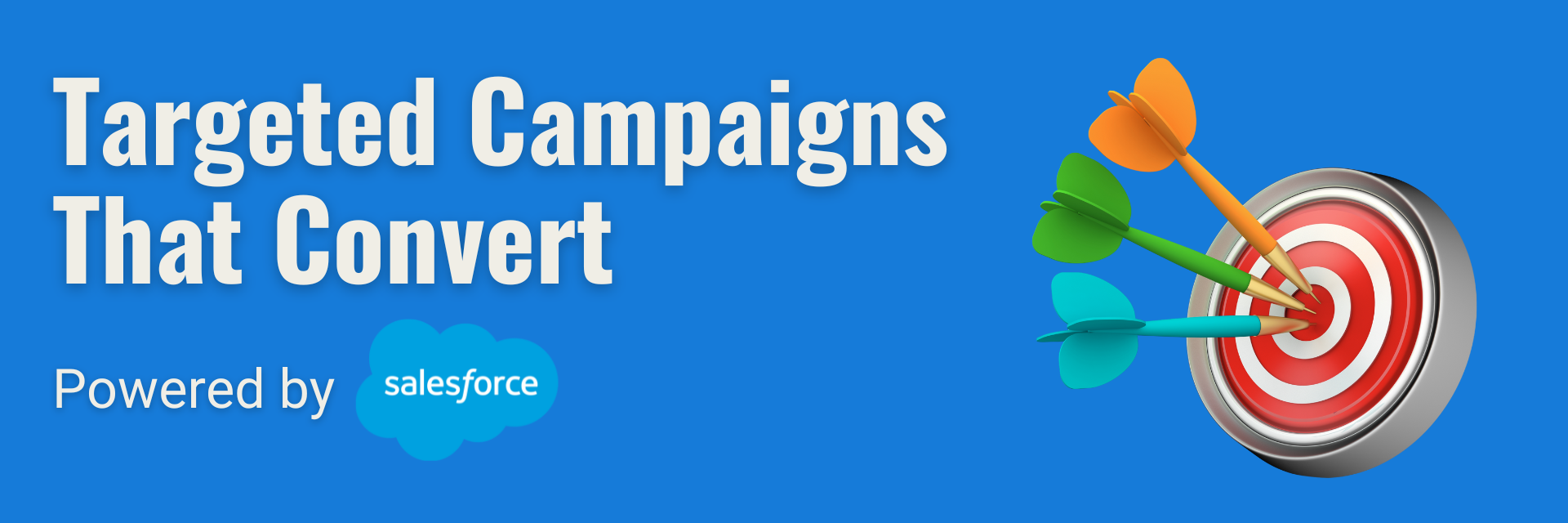
In today’s digital world, customers expect more than generic emails and one-size-fits-all promotions. They want personalized experiences that reflect their interests, behaviors, and needs. Businesses that fail to deliver risk losing engagement—and ultimately revenue.
That’s where marketing automation comes in. By combining customer data, AI insights, and automated workflows, organizations can send the right message to the right person at the right time. And when done effectively, these targeted campaigns with marketing automation don’t just drive engagement—they convert.
What Is Marketing Automation?
Marketing automation goes far beyond scheduling emails. At its core, it is about using technology to:
- Segment audiences based on behavior, demographics, or engagement.
- Create personalized customer journeys that respond to individual actions.
- Nurture leads until they are ready for sales engagement.
- Measure and optimize campaign performance in real time.
Platforms like Salesforce Marketing Cloud and Account Engagement (formerly Pardot) make this possible by centralizing data, connecting multiple channels, and layering AI-driven insights on top.
Why Targeted Campaigns Matter
Traditional “batch-and-blast” campaigns—sending the same message to everyone—rarely work anymore. Customers are bombarded with messages every day, and they only respond to those that feel relevant.
Targeted campaigns with marketing automation solve this by:
- Personalizing content to individual preferences.
- Aligning timing with when customers are most likely to engage.
- Focusing on value rather than volume.
The result? Higher open rates, more clicks, stronger engagement, and ultimately more conversions.
How Salesforce Marketing Automation Drives Results
1. Smarter Segmentation and Personalization
Instead of treating your entire database as one list, marketing automation allows you to break it down into meaningful groups. For example:
- Segment by past purchases.
- Segment by engagement levels (highly active vs. dormant).
- Segment by industry or job role.
With Salesforce Marketing Cloud, you can take this further using Einstein AI, which predicts customer preferences and suggests the best content for each individual.
2. Multi-Channel Journeys
Modern customers don’t live in just one channel. They switch between email, social media, SMS, and websites—sometimes in the same buying journey.
Marketing automation connects these channels into a seamless omnichannel journey. A customer who clicks an email link might later receive a personalized SMS reminder or see a retargeted ad on social media. All of this happens automatically, based on rules and real-time data.
3. Lead Nurturing and Scoring
Not every lead is ready to buy right away. Some need education, reminders, and trust-building before they convert.
Marketing automation enables lead nurturing: a series of timed, relevant communications designed to guide prospects along the funnel. With lead scoring, Salesforce can assign values to each lead based on their engagement—ensuring sales teams only receive qualified, high-potential leads.
4. A/B Testing and Optimization
Every audience is different, and what works for one segment may not work for another. That’s why testing is essential.
With Salesforce Marketing Cloud, you can easily run A/B tests—trying out different subject lines, images, or calls-to-action—and then automatically send the winning version to the rest of your audience. AI-driven analytics further refine future campaigns, creating a continuous cycle of improvement.
Before vs. After: The Power of Marketing Automation
Imagine a mid-sized online retailer.
Before: The company sends the same weekly newsletter to its 20,000 subscribers. Open rates are low, conversions are rare, and the marketing team spends hours manually building each campaign.
After: With Salesforce Marketing Automation, the retailer segments customers by past purchases and engagement levels. Active buyers receive tailored product recommendations, while dormant subscribers get re-engagement offers. Campaigns run automatically across email, SMS, and social—resulting in higher open rates, more conversions, and significant time savings for the team.
This example clearly shows how targeted campaigns with marketing automation create more relevant experiences and drive better results.
Three Steps to Targeted Campaigns with Marketing Automation
- Know Your Audience
Start by cleaning and organizing your data in Salesforce. Build meaningful segments and make sure you understand who your customers are and what they care about. - Design the Journey
Use Marketing Cloud Journey Builder to create automated paths for each segment. Think of it as mapping a customer’s story—from awareness to conversion—while ensuring each interaction adds value. - Measure and Improve
Track key performance metrics in real time. Look at open rates, click-throughs, conversions, and revenue attribution. Share insights with your team and continuously refine campaigns for even stronger results.
The Business Value of Marketing Automation
When implemented effectively, marketing automation offers several key benefits:
- Increased efficiency: Free teams from repetitive tasks and focus on strategy.
- Consistent customer experience: Every customer receives timely, relevant communication.
- Higher ROI: Targeted campaigns convert more leads into sales without additional spend.
- Scalability: As your audience grows, automation allows you to engage them all—without adding headcount.
Conclusion
Marketing automation isn’t just about saving time. It’s about creating targeted campaigns with marketing automation that convert by delivering the right message, to the right person, at the right moment.
With Salesforce Marketing Cloud and Account Engagement, organizations can transform customer data into personalized journeys, build smarter campaigns, and continuously optimize for better results.
Ready to see how Salesforce Marketing Automation can help you create campaigns that truly convert? Let’s talk.
Explore more articles on our blog!
The True Cost of Inefficient Workflows
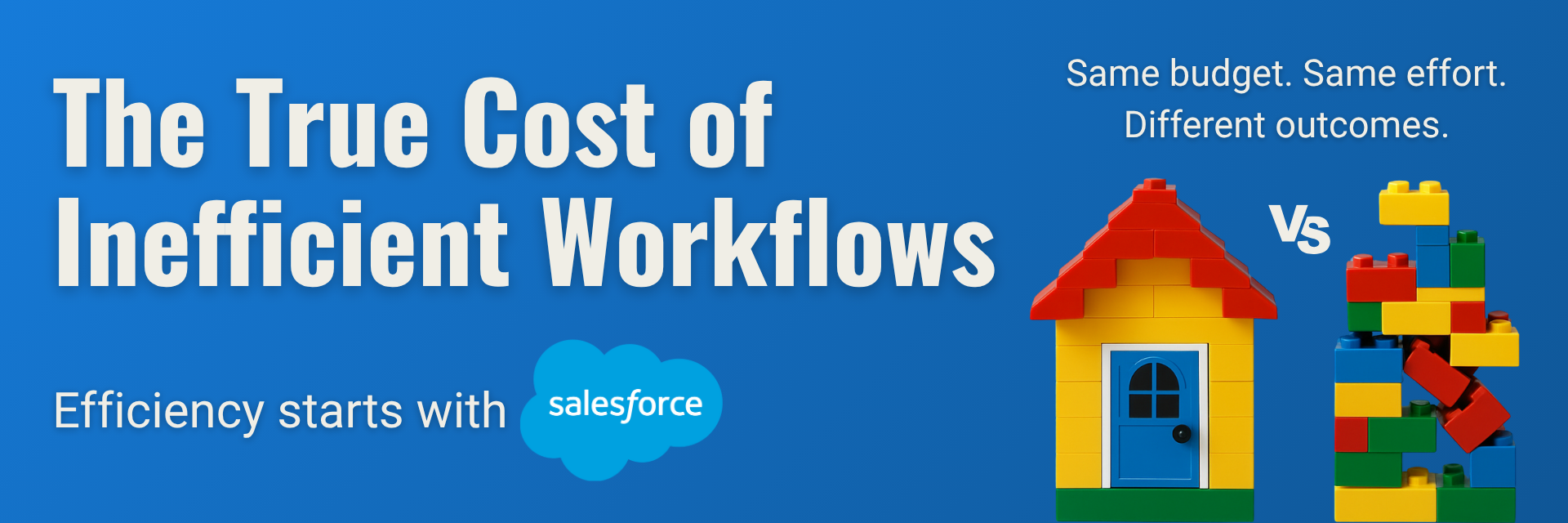
What is the true cost of inefficient workflows?
Everyone talks about productivity. But few businesses ask what inefficient workflows are really costing them.
Inefficient workflows are one of the most overlooked costs in business operations. They don’t just slow teams down — they drain resources, delay decisions, and create friction across departments. In this blog, we explore what inefficient workflows really cost your business and how better systems can drive smarter, more scalable results.
From delayed approvals to lost leads, inefficient workflows can quietly drain time, money, and morale — without making much noise. The impact might not always be visible in a single report, but over weeks and months, the costs add up. And when they do, growth slows.
Let’s take a closer look at the hidden price of broken processes — and how automation can turn things around.
1. Wasted time: The most expensive cost you can’t see
Your team is smart and capable — but how much of their time is spent on repetitive, low-value tasks?
Whether it’s manually moving data between systems, tracking status updates across email threads, or recreating the same documents from scratch, time spent on busywork is time not spent on strategic priorities. Multiply this by your entire team, and it adds up quickly.
⏱️ A study by Salesforce found that employees spend 30% of their time on non-essential tasks that could be automated.
2. Slow responses = missed opportunities
Imagine this: A high-intent lead comes in, but your sales team only follows up two days later — because the lead wasn’t routed properly or got buried in someone’s inbox. The result? Opportunity lost.
In customer service, slow case routing or resolution can damage trust. In marketing, delays in campaign approvals can throw off entire timelines.
Speed matters. And inefficient workflows slow you down exactly when you need to act fast.
3. Errors and rework: When broken processes break everything else
Manual processes often lead to human error. Think of incorrect data entries, forgotten steps, or outdated versions of a document being sent to a client.
Every error means more time spent fixing mistakes, clarifying information, or redoing work — which impacts not just efficiency, but also customer satisfaction and brand reputation.
4. Team frustration and burnout
Few things are more demotivating than working in a system that feels broken.
When employees have to constantly chase information, navigate clunky tools, or repeat the same steps without understanding why, frustration builds. Over time, that leads to disengagement — and even attrition.
Efficient workflows aren’t just about performance. They’re also about making your team’s work feel meaningful and manageable.
5. Inefficient workflows = Lack of visibility and control
When processes live in spreadsheets, inboxes, or people’s heads, it’s hard for leaders to see what’s really happening. That makes it difficult to spot bottlenecks, measure performance, or optimize workflows.
Automation introduces structure and transparency. With Salesforce, for example, every step of a process can be tracked, measured, and refined over time — giving you better control over your operations.
From friction to flow: The case for automation
The good news? These challenges are solvable.
By mapping out your business processes and identifying points of friction, you can start to design smarter workflows that are:
- Automated (no more manual status updates),
- Standardized (everyone follows the same steps),
- Trackable (real-time visibility into what’s happening).
Salesforce Flow, for instance, allows you to create intuitive, no-code automation that eliminates repetitive tasks, reduces errors, and accelerates work across teams.
Real efficiency = time + clarity + focus
Efficiency isn’t just about doing more in less time. It’s about creating space for what matters: building relationships, making strategic decisions, and delivering value to your customers.
Every minute saved through automation is a minute gained for higher-value work.
Is it time to rethink your workflows?
If your team is drowning in manual tasks, moving slowly, or working with unclear processes — it’s costing you more than you think.
Businesses often underestimate the true cost of inefficient workflows — but recognizing and addressing them is the first step toward sustainable growth.
At Target Everest, we help businesses analyze, design, and automate their Salesforce workflows to unlock speed, structure, and growth. Let us help you turn friction into flow.
Explore more articles on our blog!
How Salesforce Einstein is Transforming Sales and Customer Service
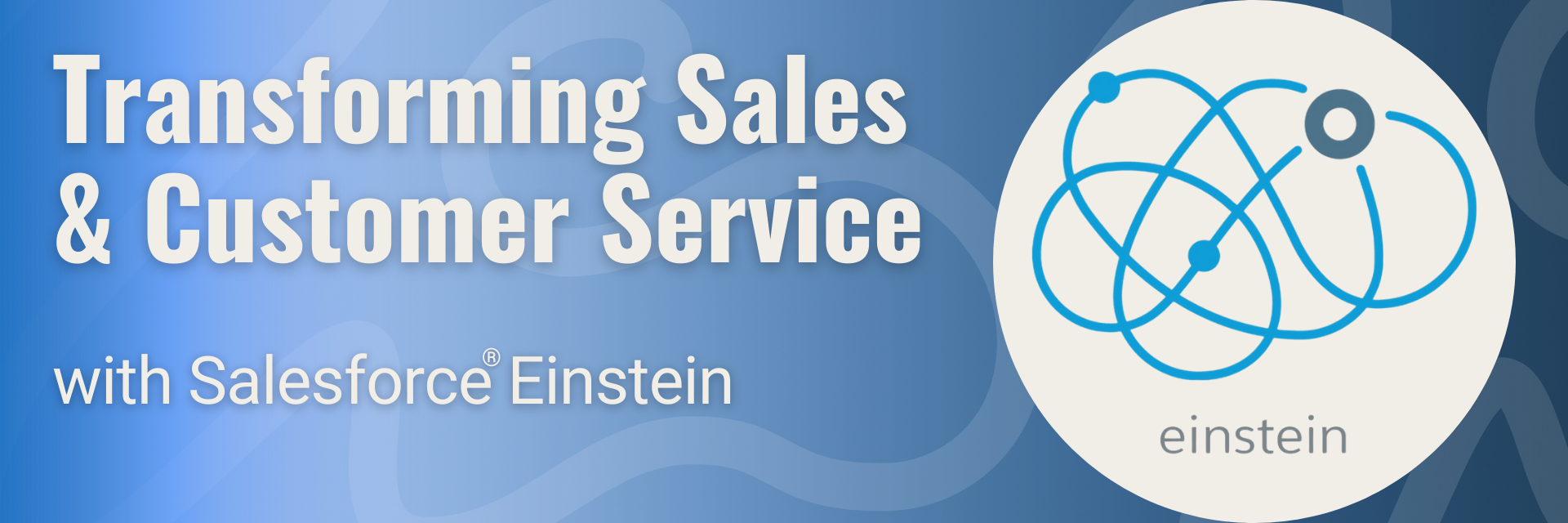
In today’s fast-paced digital landscape, businesses need more than just data — they need intelligent insights that drive action. Enter Salesforce Einstein: the AI-powered layer built directly into Salesforce CRM that empowers organisations to sell smarter and serve better.
From automating manual tasks to generating predictive insights, Salesforce Einstein is transforming how businesses approach both sales and customer service. Here’s how your team can take full advantage of what this technology has to offer.
What is Salesforce Einstein?
Salesforce Einstein is an artificial intelligence engine embedded within the Salesforce ecosystem. It combines machine learning, natural language processing (NLP), and predictive analytics to help businesses make faster, data-driven decisions.
Rather than replacing human input, Einstein enhances it — automating repetitive tasks, surfacing actionable insights, and enabling teams to focus on what matters most: building relationships and closing deals.
How Salesforce Einstein Boosts Sales
Accurate Sales Forecasting
Einstein leverages historical sales data and customer behaviour to generate highly accurate sales forecasts. This helps sales managers predict pipeline health, allocate resources effectively, and make informed strategic decisions.
Smarter Lead Prioritisation
With Einstein Lead Scoring, your sales reps no longer need to guess which leads are most likely to convert. Einstein analyses patterns in past interactions and assigns a score to each lead based on its likelihood to close, allowing teams to focus on high-potential opportunities.
Personalised Product Recommendations
Einstein analyses previous purchase history, browsing behaviour and preferences to suggest relevant products for each customer. These personalised recommendations increase upsell and cross-sell opportunities and create a more engaging customer experience.
Enhancing Customer Service with Einstein
24/7 Support with Einstein Bots
Einstein Bots provide automated, real-time assistance to customers, resolving common issues and answering FAQs around the clock. This not only improves response times but also reduces pressure on customer service teams.
Sentiment Analysis
By analysing the tone and language of customer messages, Einstein can detect emotions such as frustration or satisfaction. This allows agents to prioritise escalations and offer more empathetic responses, improving overall service quality.
Intelligent Case Recommendations
Einstein reviews a customer’s history and suggests the most appropriate next steps or support articles. This ensures faster, more accurate resolutions and contributes to a more seamless service experience.
Einstein Analytics: Smarter Decisions Through Data
Sales Performance Insights
With Einstein Analytics, sales teams gain access to detailed dashboards that highlight individual and team performance. These insights help identify what’s working — and where there’s room for improvement — in real time.
Opportunity Identification
Einstein doesn’t just report on past activity; it uncovers new opportunities before they’re even on your radar. With predictive analytics, your team can proactively reach out to customers at the right moment.
Personalising the Customer Experience
AI-Driven Marketing Campaigns
Salesforce Einstein enables marketers to create campaigns tailored to each customer’s behaviour and preferences. Whether it’s a personalised email journey or dynamic content on a landing page, Einstein ensures relevance at every touchpoint.
Virtual Assistants for Better Engagement
Virtual assistants powered by Einstein can provide fast answers, guide customers through processes, and offer context-aware suggestions based on individual customer data — all of which enhance the overall customer experience.
Implementing Salesforce Einstein in Your Organisation
Train Your Teams
To fully harness the power of Einstein, your sales and service teams need to understand its capabilities. Investing in training ensures your staff can use these tools effectively and with confidence.
Integrate with Your Salesforce CRM
Einstein works best when seamlessly integrated with your existing Salesforce CRM. This allows for consistent, centralised data usage across departments and boosts the accuracy of AI-powered insights.
Embrace Automation
Start by automating low-value, repetitive tasks like lead scoring or handling simple service queries. This frees up your team to focus on high-impact work, increasing productivity and customer satisfaction.
Final Thoughts
Salesforce Einstein represents a significant step forward in the way businesses manage customer relationships. By combining intelligent automation with deep personalisation, Einstein empowers your teams to work smarter, respond faster, and deliver more value.
Whether you’re looking to refine your sales strategy, scale your service operations, or provide exceptional customer experiences, implementing Salesforce Einstein can give your business the edge it needs to stand out in a competitive market.
Ready to make smarter decisions with Salesforce Einstein? Let’s talk.
From Hype to Impact: What Generative AI Really Means for CRM
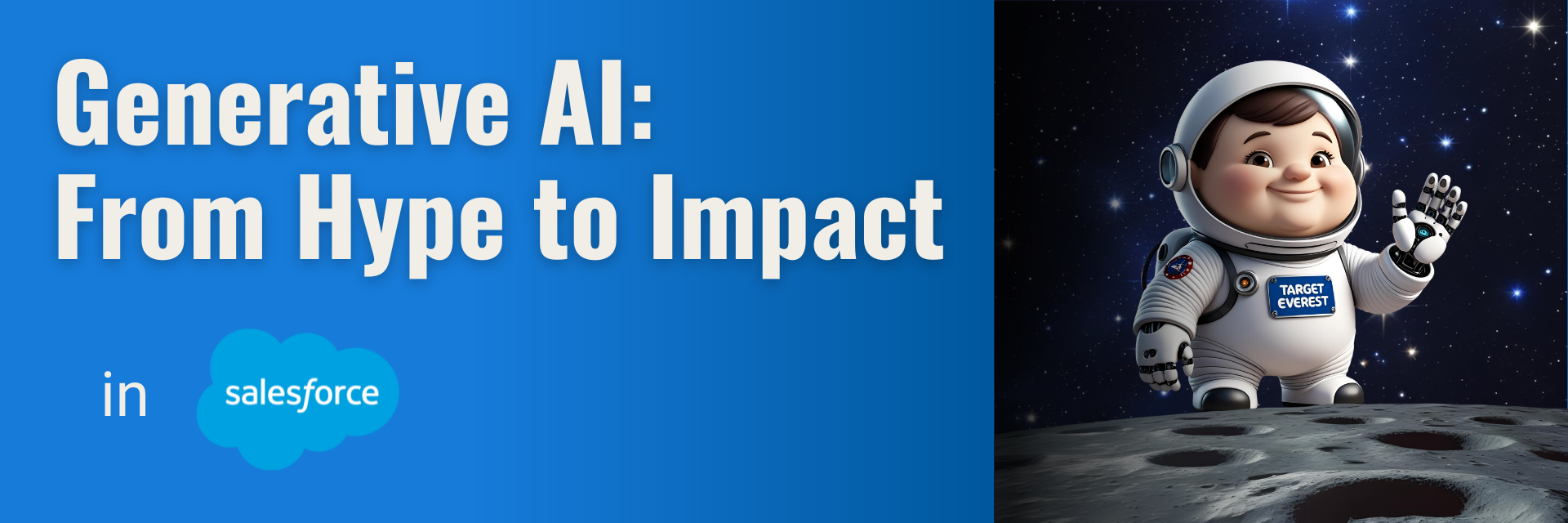
Generative AI is everywhere — in headlines, product launches, and boardroom discussions. It’s the shiny new tool everyone’s talking about. But when it comes to real-world business value, many still ask: What does generative AI actually mean for CRM?
Let’s move beyond the buzzwords and explore how this powerful technology is transforming customer relationships — not in theory, but in practice.
The Shift: From Data Storage to Dynamic Engagement
Traditional CRMs have focused on collecting and organizing customer data. Generative AI is changing that by adding intelligence and creativity to the mix.
Instead of just storing information, a CRM enhanced with generative AI can:
- Compose personalized email content based on user behavior
- Generate smart follow-up suggestions for sales reps
- Create tailored marketing journeys in minutes
- Summarize conversations and extract key insights from interactions
In other words, it turns data into action — fast, scalable, and personalized. Rather than waiting for a marketer to build a campaign from scratch or a rep to dig through notes, the AI assists in real time, enabling faster and more relevant engagement.
More Than Automation — It’s Intelligent Enablement
Basic automation saves time. Generative AI takes it further by adding contextual intelligence.
For example:
- A service agent doesn’t just get a macro — they get an AI-suggested response tailored to the customer’s tone and history.
- A marketer doesn’t just segment users — they receive content drafts optimized for specific personas and channels.
- A sales rep doesn’t just get reminders — they get suggested talking points or next actions based on pipeline patterns and deal risk indicators.
Generative AI doesn’t replace people — it empowers them. It frees up human capacity for judgment, relationship-building, and strategic thinking, while AI handles the repetitive or data-heavy tasks. That’s a major mindset shift from automation to augmentation.
Redefining Personalization at Scale
CRM systems have always promised personalization. But delivering truly relevant, timely, and engaging experiencesacross thousands (or millions) of customers? That’s been nearly impossible — until now.
Generative AI enables:
- Real-time content generation based on individual profiles and behavior
- Next-best-action recommendations powered by predictive models
- Adaptive journeys that shift dynamically as users engage
A key example is campaign variant generation: instead of A/B testing two subject lines, marketers can test 20 versions generated by AI, tailored to different segments. This allows for hyper-personalized engagement at scale, something human teams could never achieve alone.
And because AI continuously learns from interaction data, those experiences evolve and improve over time — becoming more relevant, more effective, and more human-like.
Trust Still Matters: AI Must Be Responsible and Transparent
With great power comes great responsibility. As generative AI tools become more embedded in CRM workflows, companies must ensure:
- Data privacy and compliance (especially with sensitive customer data)
- Human oversight of AI-generated outputs
- Bias detection and mitigation in AI recommendations and language
Customers won’t tolerate AI that feels intrusive or impersonal. Nor will regulators. Responsible AI practices are not just about ethics — they’re critical to sustaining trust and brand reputation in an increasingly AI-powered environment.
Getting Started: How to Approach Generative AI in Your CRM Strategy
The possibilities are exciting — but don’t try to do everything at once.
Start with high-impact, low-risk use cases like:
- Auto-generating marketing content for emails or ads
- Using AI for summarizing service interactions
- Implementing AI-powered lead scoring in sales
Make sure every use case is connected to a clear business goal (e.g., saving time, increasing engagement, improving customer satisfaction). Collaborate with key stakeholders early, and treat AI as a strategic partner, not just a technical upgrade.
Over time, generative AI will reshape how you think about CRM — not as a database or a toolset, but as a living, learning system that evolves with your customers and your business.
The Real Value of Generative AI in CRM
Generative AI isn’t just a flashy trend. It’s a fundamental shift in how we manage customer relationships.
From marketing and sales to service and beyond, generative AI has the potential to:
- Enhance productivity
- Improve customer satisfaction
- Accelerate time-to-market
- Drive measurable business outcomes
But only if we move beyond the hype — and start using it with purpose.
CRM is no longer just a system of record. With generative AI, it becomes a system of intelligence, creativity, and action.
Ready to unlock the power of AI within your Salesforce environment?
We help ensure that intelligent features aren’t just available — but actually create real value for your business.
Explore more articles on our blog!
Agentforce World Tour 2025

Agentforce World Tour Lisbon 2025: An Immersive Journey into the AI-Powered CRM Revolution
On June 4, 2025, Lisbon hosted one of the year’s most anticipated events: the Agentforce World Tour Lisbon. Held at the Lisbon Congress Center, this dynamic gathering brought together business leaders, tech innovators, and AI enthusiasts to explore the future of customer relationships in the age of Salesforce Autonomous AI Agents.
Event Highlights:
Innovation at the Core
Live demos and hands-on workshops showcased how generative AI and autonomous agents can boost business productivity and transform CRM experiences by working seamlessly alongside human teams.
Real Success Stories
Top companies from various industries shared their practical use cases and results after adopting Agentforce solutions to streamline operations and increase customer engagement.
Inspiring Speaker Line-up
The event featured outstanding speakers, including:
Ana Rita Ramos (Associação Nuvem Vitória), Miguel Barreto Pontes (Banco BPI), André Sousa (IBG Global), André Garcês (Perrigo), Armando Santos (CGD), Bruno Oliveira (Coverflex), Carla Cruz (CGD), Cláudia Carvalho (Portugal Duty Free), Hélio Branco (Despomar), Hugo Gonçalves (Sumol Compal), Inês Rosa (Vila Galé Hotels), Joana Rabello (Worten Portugal), José Peixoto (Haitong Bank), Mariana Romão (Wells Portugal), Mariana Henriques (INDASA), Mário Grilo Ferreira (CGD), Paulo Pereira (MEO), Raul Novais (INDASA), Rui Palma (Floene), Rui Rosa (Grupo Barraqueiro), and Telmo Gomes (ASCENDUM).
Target Everest’s Participation
Target Everest, known for its deep Salesforce expertise, made a strong presence at the event as a trusted implementation partner. The company highlighted its successful track record in delivering tailored CRM solutions powered by AI, helping organizations unlock new levels of efficiency and customer success.
We were thrilled to welcome so many participants at our stand — it was a real pleasure to get to know your unique journeys, explore your goals, and hear more about the challenges and ambitions that drive your organizations. Engaging in these conversations inspires us to keep delivering impactful, results-driven Salesforce solutions.
In Summary
The Agentforce World Tour Lisbon 2025 was more than just a tech event — it was a bold vision of what the future holds for CRM and business innovation. With AI at the forefront, organizations are now empowered to work smarter, serve faster, and engage customers like never before.
📸 We’re also sharing below some snapshots from the event — we had a wonderful day and enjoyed every moment!
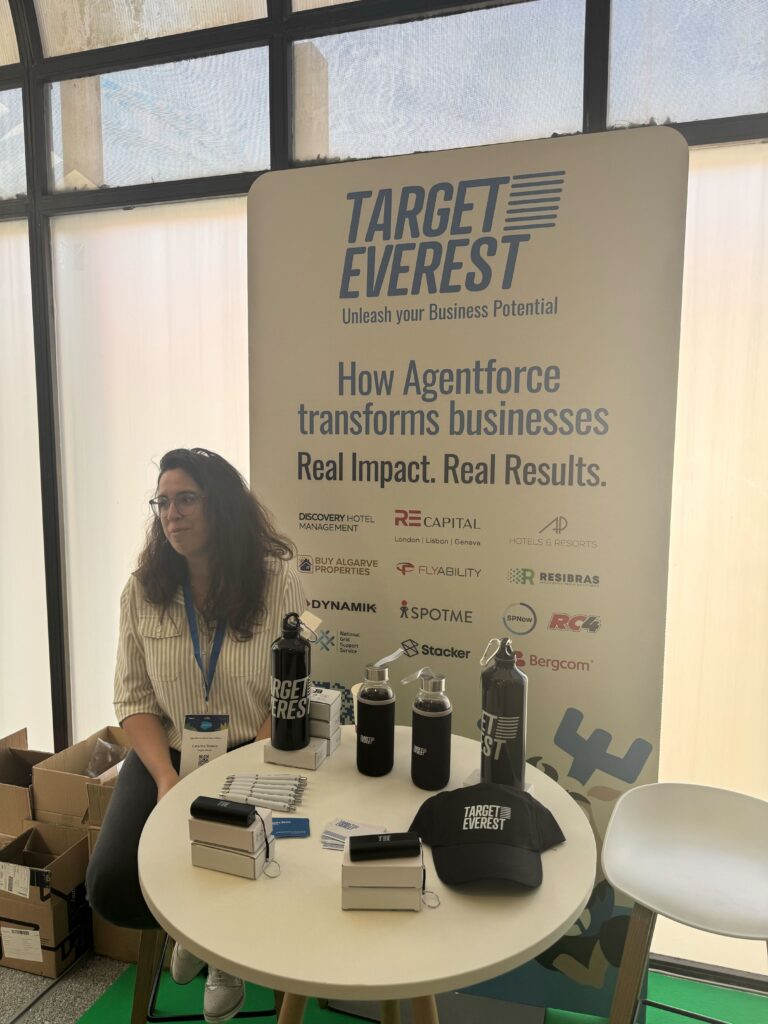
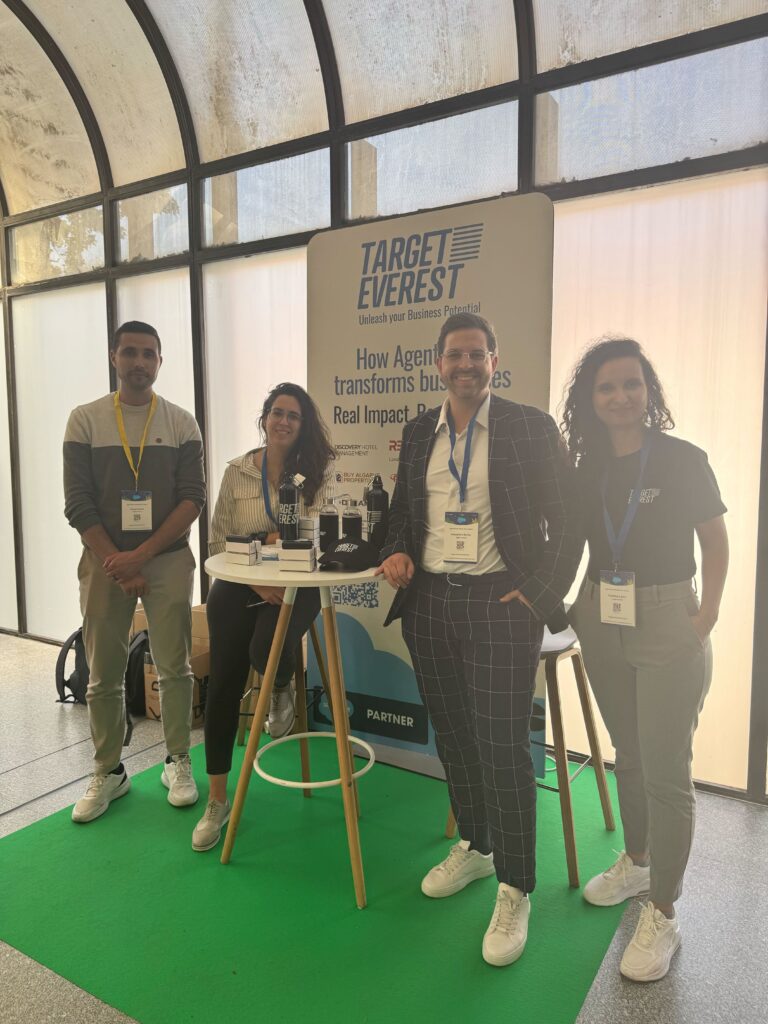

👉 If you’re interested in exploring how we can support your company with Salesforce solutions, feel free to fill out the form and we’ll get in touch shortly!
Explore more articles on our blog!
Automating Processes with Salesforce: Efficiency and Productivity
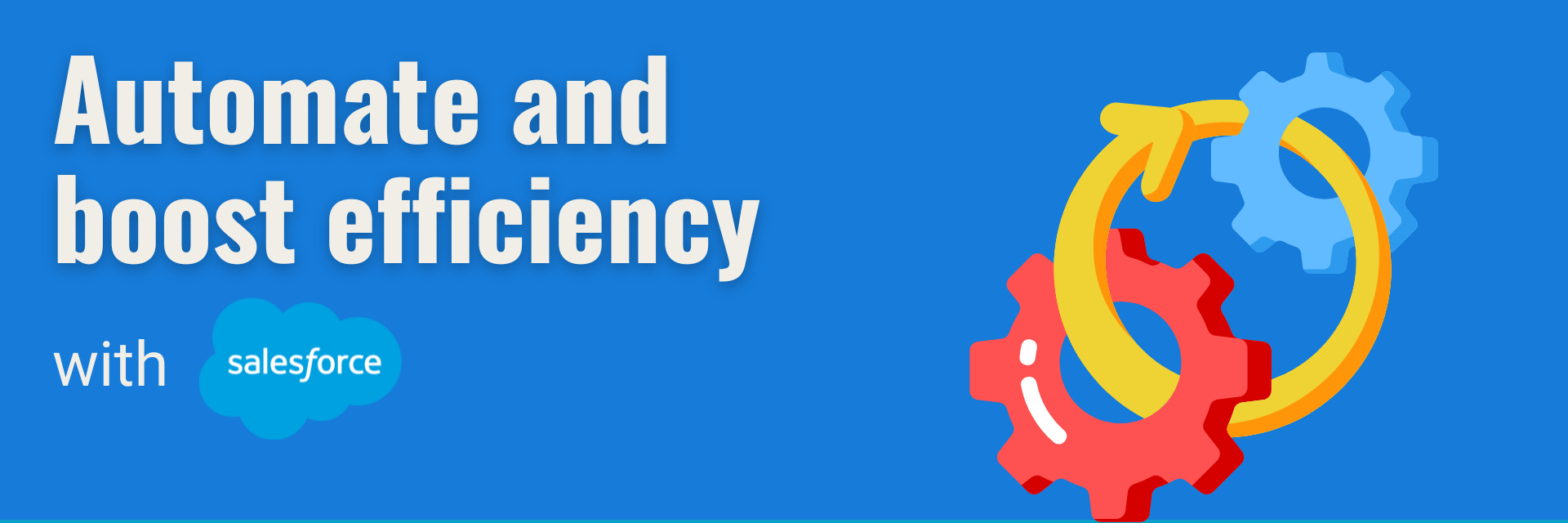
1. Introduction to Automation with Salesforce
In an increasingly digital and competitive business environment, efficiency is crucial. Companies are constantly looking for ways to streamline operations, reduce manual effort, and improve productivity. Salesforce, a leading CRM platform, offers powerful automation tools designed to enhance business processes and free up teams to focus on strategic initiatives.
Automation within Salesforce allows businesses to eliminate repetitive tasks, minimise errors, and create seamless workflows. Whether it’s automating lead qualification, customer interactions, or report generation, implementing automation correctly can transform the way companies operate.
2. Benefits of Process Automation
Investing in process automation with Salesforce brings several key advantages:
- Reduction of Manual Tasks & Errors: Automated workflows eliminate the need for repetitive data entry, reducing human error and ensuring data consistency.
- Time Efficiency: With automation, teams can redirect their focus from administrative tasks to strategic decision-making and customer engagement.
- Consistency & Standardisation: Automated processes ensure that all tasks follow the same set of rules, maintaining compliance and improving service quality.
- Scalability: As businesses grow, automation ensures that operations remain efficient without the need for excessive manual intervention.
3. Key Salesforce Automation Tools
Salesforce provides a range of tools to help businesses automate workflows and processes. Some of the most commonly used include:
- Salesforce Flow: A visual workflow automation tool that allows users to create and optimise business processes without the need for complex coding.
- Apex: A programming language that enables the development of custom automation for more sophisticated business needs.
- Einstein Automate: AI-driven automation that enables intelligent process optimisation, making workflows smarter and more efficient.
4. Common Use Cases for Automation
Automation within Salesforce is widely used across different business functions. Here are some of the most impactful applications:
- Lead Scoring & Qualification: Automating the qualification of leads based on predefined criteria ensures that sales teams focus on high-value prospects (Using Marketing Cloud Account Engagement Cloud).
- Automated Reports & Dashboards: Businesses can schedule automatic report generation to ensure real-time visibility into performance metrics.
- Follow-up Emails & Notifications: Automating follow-ups help maintain timely and personalised customer engagement.
- Case Management Automation: Support teams can streamline customer service by assigning cases based on workload and expertise.
5. Implementing Automation in Salesforce
Adopting automation in Salesforce requires a structured approach to ensure smooth execution and maximum impact:
- Identify Processes to Automate: Evaluate existing workflows to determine which tasks are repetitive and time-consuming.
- Choose the Right Tool: Depending on the complexity of automation, select the most suitable Salesforce tool (Flow, Apex, etc.).
- Design & Build the Workflow: Develop automation processes that align with business objectives and operational needs.
- Test & Optimise: Conduct testing to refine and improve automation workflows before full deployment.
- Monitor & Adjust: Continuously measure performance and make necessary adjustments to optimise efficiency.
6. Challenges of Automation
While automation brings numerous benefits, there are also challenges that businesses need to consider:
- Understanding Existing Processes: Automation is only effective when applied to well-structured workflows. Poorly designed processes can lead to inefficiencies.
- Over-Reliance on Automation: While automation is a powerful tool, some tasks still require human intervention to maintain a personalised customer experience.
- Change Management: Implementing automation requires businesses to train employees and ensure smooth adaptation to new workflows.
7. Measuring Efficiency & Productivity
To determine the success of automation, businesses should track relevant Key Performance Indicators (KPIs), such as:
- Task Completion Time: Measure how much time is saved through automation.
- Error Reduction Rate: Track improvements in data accuracy and consistency.
- Process Completion Rate: Monitor how effectively automated workflows are functioning.
- Employee & Customer Feedback: Gather insights from users to refine and improve automation strategies.
In conclusion, Salesforce automation is a game-changer for businesses looking to boost efficiency, productivity, and scalability. By leveraging the right tools and best practices, companies can create seamless workflows that reduce manual workload and enhance overall performance.
If you’re ready to optimise your Salesforce processes, we are here to help.
Let’s explore how automation can drive success for your business!
Explore more articles on our blog!
Do you want to hear more?
Our team of experts specializes in Salesforce and is dedicated to providing top-notch services to help your business succeed. If you're looking for Salesforce® solutions or have any questions, please feel free to reach out to us. We'd love to hear from you.
Contact us

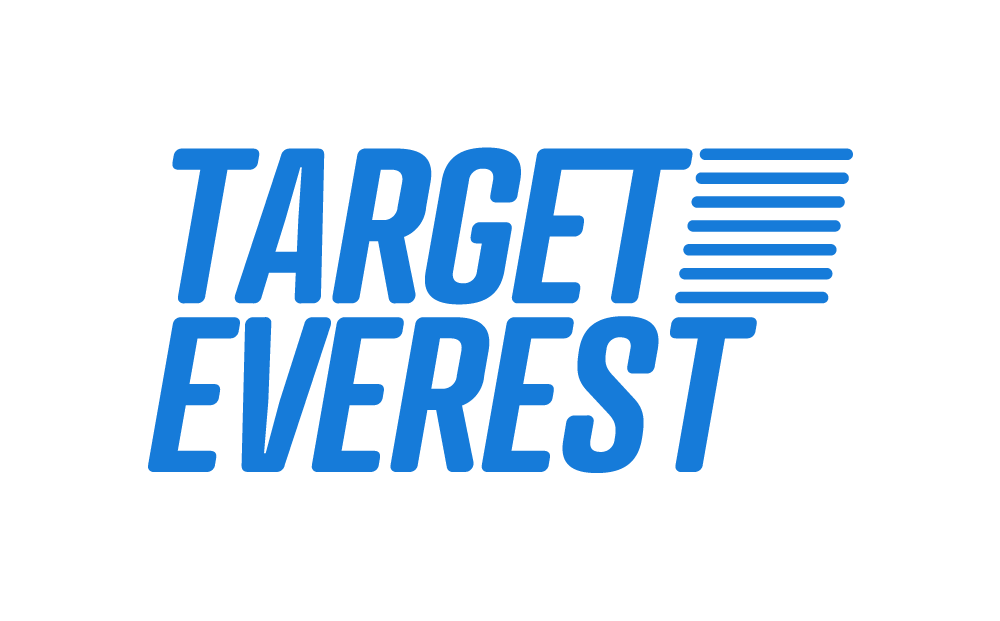 Target Everest |
Target Everest |